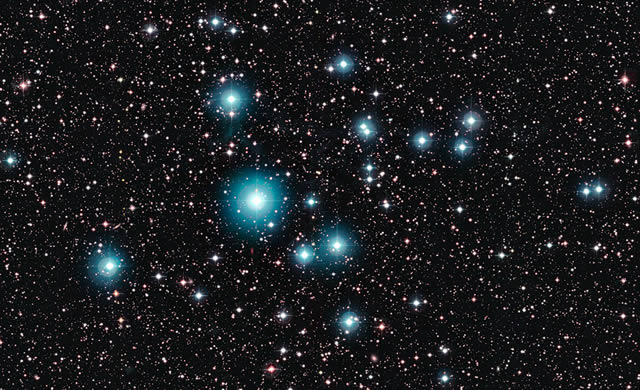
Questa graziosa spolverata di stelle blu brillanti è l’ammasso NGC 2547, un gruppo di stelle di recente formazione nella costellazione australe della Vela. L’immagine è stata ottenuta dal WFI (Wide Field Imager) sul telescopio da 2,2 metri dell’MPG/ESO all’Osservatorio di La Silla in Cile.
L’Universo è un borgo antico – ha circa 13,8 miliardi di anni. Anche la nostra galassia, la Via Lattea, ha una veneranda età – alcune delle sue stelle hanno più di 13 miliardi di anni (eso0425). Nonostante ciò è ancora molto attiva: nuovi oggetti si formano e altri vengono distrutti. In questa immagine si possono vedere alcuni dei più recenti arrivi, le giovani stelle che formano l’ammasso NGC 2547. Ma queste stelle sono veramente dei giovanotti su scala cosmica? Anche se la loro esatta età è incerta, gli astronomi stimano che NGC 2547 abbia dai 20 a 35 milioni di anni, cioè non tanto giovane, dopo tutto. Ma il nostro Sole ha circa 4600 milioni di anni e non ha ancora raggiunto la mezz’età. Ciò significa che se si pensa al Sole come una persona di 40 anni, le stelle brillanti nell’immagine sono infanti di tre mesi. La maggior parte delle stelle non si formano in isolamento, ma negli ammassi ricchi, con dimensioni che vanno da diverse decine a diverse migliaia di stelle. Se NGC 2547 contiene molte stelle calde che risplendono di blu brillante, un segno inequivocabile di gioventù, se ne possono trovare anche alcune, gialle o rosse, che sono già evolute fino a diventare giganti rosse. Gli ammassi stellari aperti come questo hanno vite relativamente brevi, dell’ordine di parecchie centinaia di milioni di anni, prima di disintegrarsi e lasciare che le stelle componenti si allontanino. Gli ammassi sono oggetti chiave per gli astronomi che studiano come le stelle evolvono durante la loro vita. I membri di un ammasso sono nati tutti dallo stesso materiale e circa nello stesso momento, rendendo più semplice la determinazione degli effetti delle altre proprietà stellari. L’ammasso stellare NGC 2547 si trova nella costellazione australe della Vela, circa 1500 anni luce dalla Terra, ed è abbastanza brillante per essere visibile facilmente con un binocolo. È stato scoperto nel 1751 dall’astronomo francese Nicolas-Louis de Lacaille durante una spedizione astronomica al Capo di Buona Speranza in Sud Africa, usando un telescopio molto piccolo, di meno di due centimetri di apertura. Tra le stelle brillanti di questa immagine si vedono molti altri oggetti, specialmente nell’ingrandimento. Molti sono stelle più deboli o più distanti nella Via Lattea, ma alcuni, che appaiono estesi e sfuocati, sono galassie, a milioni di anni luce dalle stelle nel campo di vista.
Fonte/Leggi tutto → ESO.org
This pretty sprinkling of bright blue stars is the cluster NGC 2547, a group of recently formed stars in the southern constellation of Vela (The Sail). This image was taken using the Wide Field Imager on the MPG/ESO 2.2-metre telescope at ESO’s La Silla Observatory in Chile.
The Universe is an old neighbourhood — roughly 13.8 billion years old. Our galaxy, the Milky Way, is also ancient — some of its stars are more than 13 billion years old (eso0425). Nevertheless, there is still a lot of action: new objects form and others are destroyed. In this image, you can see some of the newcomers, the young stars forming the cluster NGC 2547. But, how young are these cosmic youngsters really? Although their exact ages remain uncertain, astronomers estimate that NGC 2547’s stars range from 20 to 35 million years old. That doesn’t sound all that young, after all. However, our Sun is 4600 million years old and has not yet reached middle age. That means that if you imagine that the Sun as a 40 year-old person, the bright stars in the picture are three-month-old babies. Most stars do not form in isolation, but in rich clusters with sizes ranging from several tens to several thousands of stars. While NGC 2547 contains many hot stars that glow bright blue, a telltale sign of their youth, you can also find one or two yellow or red stars which have already evolved to become red giants. Open star clusters like this usually only have comparatively short lives, of the order of several hundred million years, before they disintegrate as their component stars drift apart. Clusters are key objects for astronomers studying how stars evolve through their lives. The members of a cluster were all born from the same material at about the same time, making it easier to determine the effects of other stellar properties. The star cluster NGC 2547 lies in the southern constellation of Vela (The Sail), about 1500 light-years from Earth, and is bright enough to be easily seen using binoculars. It was discovered in 1751 by the French astronomer Nicolas-Louis de Lacaille during an astronomical expedition to the Cape of Good Hope in South Africa, using a tiny telescope of less than two centimetres aperture. Between the bright stars in this picture you can see plenty of other objects, especially when zooming in. Many are fainter or more distant stars in the Milky Way, but some, appearing as fuzzy extended objects, are galaxies, located millions of light-years beyond the stars in the field of view.
Source/Continue reading → ESO.org

















